While all the early boat-building was happening, I found time to get quite involved in Rugby League. I had played a bit at school at St. Pat’s but nothing serious. The first real team that I hooked up with was the Banksia Waratahs in 1947 in ‘D’ Grade with a weight limit of 8 stone 7 pounds. My position was half back – a position that two of my older brothers had also played in. Our team won the competition and I had a pretty good year.
The following year I joined with mates Bill McNamara, Ken Biddulph and John Montgomery and we all played for Marist Brothers Old Boys in ‘C’ Grade. We went on to win the competition for the next three years – one season our line was never crossed. Quite a number of players in these teams went on to play Grade football for St. George.
In 1950, I was selected to play in the President’s Cup for St. George District (President’s Cup was for footballers under the age of 21 years). Norm Provan was one such player to go on from that team and play international football for many years.
The following year, 1951, I tried out for St. George and was selected as a third grader but fortunately for me, the reserve grade half was somehow not available and I got to be the reserve grade half for the year.
In 1952, when I was 20 years old, I went to Jindabyne (the old Jindabyne down in the valley; not the new one up above the waterline) as Captain/Coach and on contract, for the total package of free board, a job as a carpenter plus twenty pounds a week to play footie. I really thought I had hit the big time!
Travelling to Jindabyne in 1952 was a bit of an epic journey. There was a steam train from Central Station in Sydney which consisted of an all-night trip to Cooma and then on arrival in Cooma a bus to Jindabyne. I remember the trip well, particularly approaching Berridale, the little town between Cooma and Jindabyne. The highway was a red gravel road lined with beautiful tall poplar trees not yet dropping their leaves.
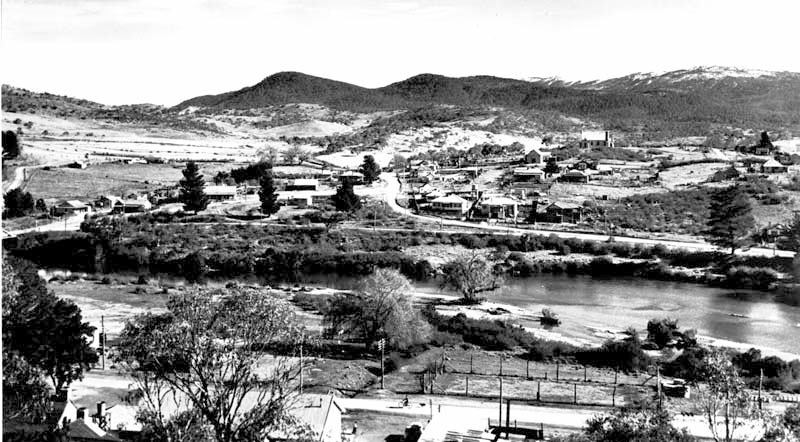
Jindabyne c1952 (Old pub in very left hand corner of snap with chimneys standing out these chimneys were in the vicinity of my bedroom. First training ground was the bare patch in lower left on the other side of the road to the pub)
Arriving at my destination I was met by the local committee and shown to my accommodation in the old stone pub. The walls were about two foot thick, in a little room about 8 feet by 7 feet. This was to be my home for the next four months.
At this time the Snowy Mountains Hydro-Electric scheme was under construction and Jindabyne was just like a frontier town that we used to see in the Hollywood Western movies. The workers used to hit town every few weeks and really let it rip, blowing their money on booze and women. The good time ladies used to arrive in flash cars every Friday afternoon and the queue for their services stretched out for what seemed like a hundred metres.
There were only four teams in the football competition; Jindabyne, Cooma, Bombala and Adaminaby.
My first training night was quite an experience; the first shock was that the training field was the paddock opposite the pub and the only lighting was provided by a dozen or more cars situated around the fences.
The next shock was the training gear the players wore. I was togged out in my St. George Jumper, white shorts and footie boots. It was a freezing night (it was always a freezing night in Jindabyne), and here were the locals in long trousers, jacket, hats and riding boots. The next training night, I too dressed like a local.
The team was mostly made up from three local families. The rest were an Irishman, Arthur Costello, who had never played football, the local copper, Bruce Lang and me. We won our share of matches and had a great time.
While there I made the representative side; group 11 combined with group 10 South Coast to play a Sydney side for Country Week. We played Parramatta and I got flattened and carted off on a stretcher. However, I recovered to take my place for the second half, but we got beaten anyway.
I had my 21st Birthday at Jindabyne standing on a keg in the bar of the pub; it was a great party night.
I was also introduced to snow skiing while there as I did not work on a Saturday so I had the chance to go to the snowfields at Perisher.
Mostly I got out of town to keep out of trouble and I also got my first car while there. My brother-in-law, Alan Sutton, picked it up for me. The car was a 1948 MG Tourer, and I came to Sydney and drove it back to the bush. It was a great little car and I had a lot of fun out of it, both in the bush and back home in Sydney.
After Jindabyne I was back with St. George and was graded No 20 half for the reserves. But again I was lucky. I had been playing great footie in the trials and should have been placed in 1st grade, but the club had signed a country bloke up, so he got the grading. However, at the first game of the season, he had a shocker at North Sydney Oval, and they pulled him off at half time and sent me on after I had already played a full game for the reserves. I kept the spot for the rest of the 1953 season.
My best performance for the year was on Sydney Cricket Ground when I was judged best and fairest and awarded the Sydney Morning Herald prize of 10 pounds. At the end of the season we were beaten in the final by South Sydney.
In 1954, Val and I became engaged and I decided I would go to the country again to put a bit of money together as we planned on getting married the next year when she turned 21. We had sold the car and bought a block of land at Northcote Avenue, Caringbah.
After contacting Ray Stehr (an old International who my brother Joe had been in the RAAF with), and who, at that time was organising those sort of deals, he set up a meeting with Parkes Rugby League and I signed up to a Captain/Coach job with them. Terms were good as my full 1st Grade bonus with St. George was one hundred and eighty one pounds and Mum had to wash my jumper and shorts.
Parkes in 1954 was a different set up compared to Jindabyne as they were a pretty well organised group of people headed by a detective named Kevin Keeble. It was a much bigger competition and with 10 teams competing, it entailed quite a lot of travelling. They were keen to do well in the competition, as that year the English Rugby League touring team was due to play a combined Western Division side at Bathurst later in the year.
I had a job as a carpenter for a five day working week but Saturday again was a bit of a drag. However, another committee man who was a bookmaker came to the rescue and took me on as his change clerk, which was all pretty foreign to me. It took a while for me to become used to some of the track slang. The first time he said to pay that bloke a ‘monkey’ I didn’t know what to do but the penciller set me straight and after a while I found it quite interesting, although I never had a bet myself. I was up there to save the money that the bookie used to sling depending on the day. On a good day I would get 20 pounds, fantastic money, especially as my weekly job wage was the same amount.
The accommodation was pretty good. My room was on the first floor opening on to a full length verandah, the meals were excellent and I even got the maids to do my washing after a while. I think they took pity on me after seeing a couple of my attempts. On one occasion I washed a green shirt with a white one and finished up with two green shirts so I was only too happy to relieve myself of that chore.
I was fortunate to make the combined Western Division side and captained the team against Great Britain at Bathurst. We were beaten but I felt very proud to have had the opportunity to be selected.
We went on to win the competition after quite a bit of controversy. Unfortunately I had broken a bone in my foot and did not get to play in the finals.

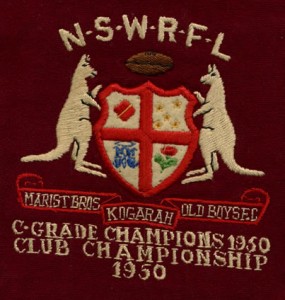
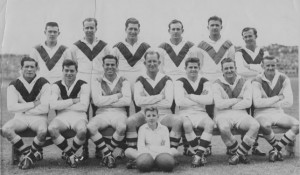
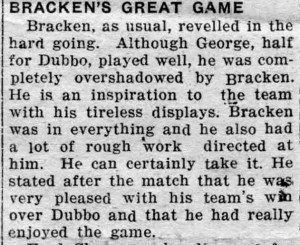
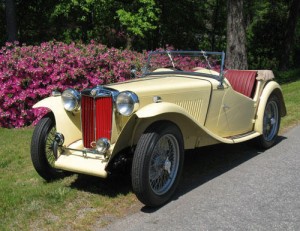
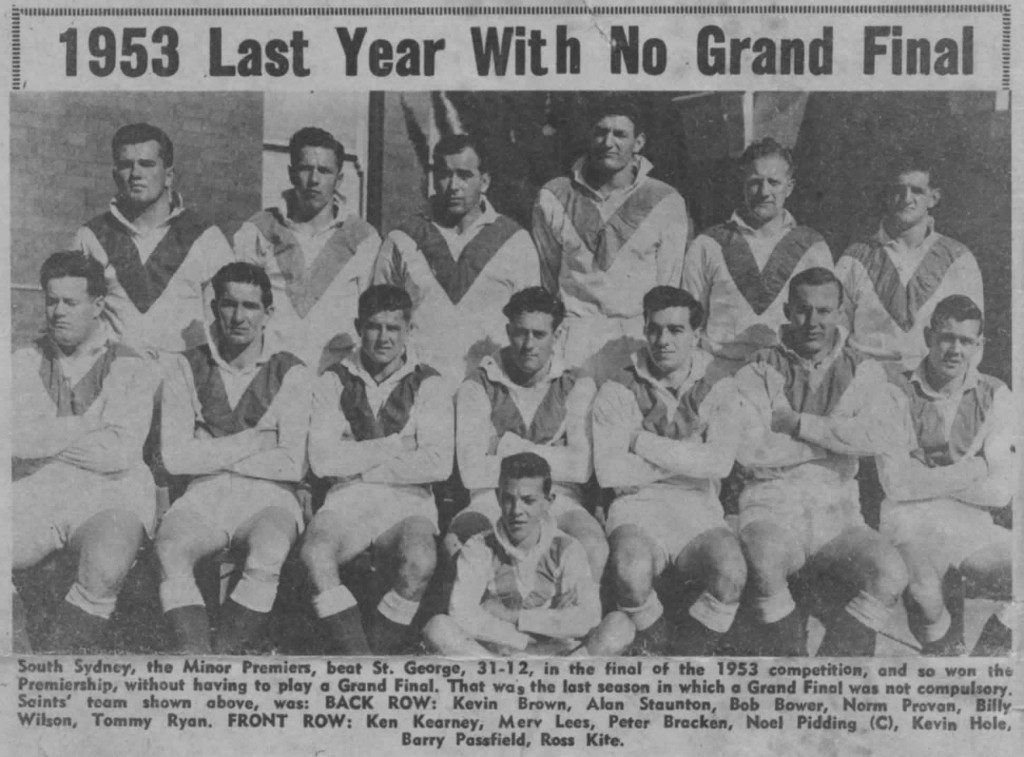
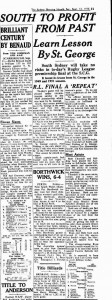
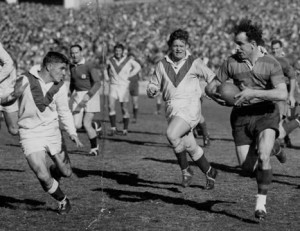
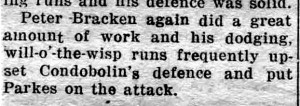
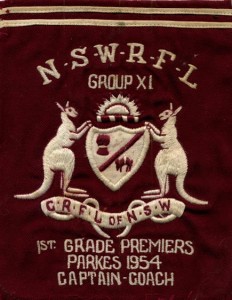
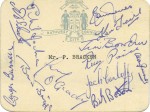
What a great story you have written. I, of course, remember you from the St. George days. You would probably know that Barry died in 1985. I have continued to live in the Shire which was my birthplace. Have had occasional contact with Lois and Kevin Hole. Norm Provan was a great friend through the years but I have not been in touch with him and Lynne lately. Carol has told me that his health has much declined. Very interested in your details about Garden Island. My uncle, Syd Thompson completed his apprenticeship there, went to Manus Island in 1951, returned and retrained as a Manual Arts teacher, appointed to Port Hacking HS, taught there until retirement and died in 2019. Hope you and Val are in good health.